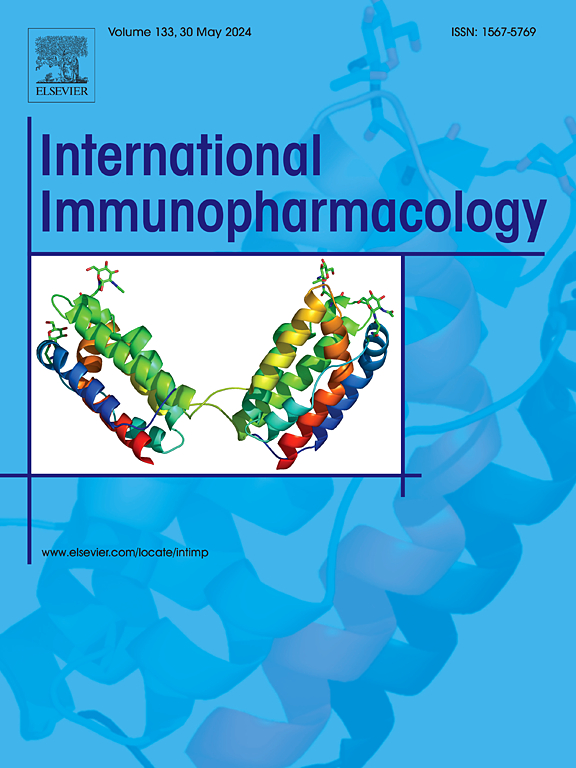糖尿病通过破坏il -33介导的牙周韧带成纤维细胞和巨噬细胞之间的相互作用而加剧牙周炎。
IF 4.8
2区 医学
Q2 IMMUNOLOGY
引用次数: 0
摘要
具有免疫调节特性的组织驻留成纤维细胞最近被确定为炎症的关键参与者。然而,它们在糖尿病相关牙周炎的牙周生态位中的作用仍不清楚。白细胞介素(IL)-33,在炎症反应中被称为“警报素”,最近被认为是牙周炎的潜在诱因。本研究表明,在体内糖尿病相关性牙周炎模型和体外糖尿病炎症模型中,牙周韧带成纤维细胞(PDLFs)中的IL-33水平降低。在体外共培养模型中,PDLFs中IL-33的过表达促进了M2型巨噬细胞的极化,而PDLFs中IL-33的敲低则引发了M1型巨噬细胞的极化。值得注意的是,在体内补充IL-33可显著缓解牙周组织破坏并增强M2巨噬细胞浸润,而在糖尿病相关牙周炎中,靶向IL-33/ST2轴会加重组织损伤并促进M1巨噬细胞极化。此外,cut&run实验证实了yes相关蛋白(YAP)对IL-33的直接调控。这些发现表明,PDLFs中IL-33缺乏有利于M1巨噬细胞极化,从而加剧了糖尿病相关性牙周炎的发病机制。我们的研究强调了PDLFs在创造炎症生态位中的重要免疫调节作用,并揭示了糖尿病相关牙周炎中PDLFs和巨噬细胞之间新的相互作用轴。本文章由计算机程序翻译,如有差异,请以英文原文为准。

Diabetes exacerbates periodontitis by disrupting IL-33-mediated interaction between periodontal ligament fibroblasts and macrophages
Tissue-resident fibroblasts with immunomodulatory properties have recently been identified as key players in inflammation. However, their roles within the periodontal niche in diabetes-associated periodontitis remain unclear. Interleukin (IL)–33, known as an “alarmin” in inflammatory responses, has recently emerged as a potential contributor to periodontitis. Herein, we show that IL-33 levels are reduced in periodontal ligament fibroblasts (PDLFs) in the in vivo models of diabetes-associated periodontitis and in vitro models of diabetic inflammation. In the in vitro co-culture model, overexpression of IL-33 in PDLFs promotes M2 macrophage polarization, while knockdown of IL-33 in PDLFs instigates M1 macrophage polarization. Notably, supplementation with IL-33 in vivo significantly alleviates periodontal tissue destruction and enhances M2 macrophage infiltration, whereas targeting the IL-33/ST2 axis exacerbates tissue damage and promotes M1 macrophage polarization in diabetes-associated periodontitis. Additionally, the CUT&RUN assay confirms the direct regulation of IL-33 by Yes-associated protein (YAP). These findings demonstrate that IL-33 deficiency in PDLFs favors M1 macrophage polarization, thereby exacerbating the pathogenesis of diabetes-associated periodontitis. Our study underscores the essential immunomodulatory role of PDLFs in creating an inflammatory niche and unveils a novel interaction axis between PDLFs and macrophages in diabetes-associated periodontitis.
求助全文
通过发布文献求助,成功后即可免费获取论文全文。
去求助
来源期刊
CiteScore
8.40
自引率
3.60%
发文量
935
审稿时长
53 days
期刊介绍:
International Immunopharmacology is the primary vehicle for the publication of original research papers pertinent to the overlapping areas of immunology, pharmacology, cytokine biology, immunotherapy, immunopathology and immunotoxicology. Review articles that encompass these subjects are also welcome.
The subject material appropriate for submission includes:
• Clinical studies employing immunotherapy of any type including the use of: bacterial and chemical agents; thymic hormones, interferon, lymphokines, etc., in transplantation and diseases such as cancer, immunodeficiency, chronic infection and allergic, inflammatory or autoimmune disorders.
• Studies on the mechanisms of action of these agents for specific parameters of immune competence as well as the overall clinical state.
• Pre-clinical animal studies and in vitro studies on mechanisms of action with immunopotentiators, immunomodulators, immunoadjuvants and other pharmacological agents active on cells participating in immune or allergic responses.
• Pharmacological compounds, microbial products and toxicological agents that affect the lymphoid system, and their mechanisms of action.
• Agents that activate genes or modify transcription and translation within the immune response.
• Substances activated, generated, or released through immunologic or related pathways that are pharmacologically active.
• Production, function and regulation of cytokines and their receptors.
• Classical pharmacological studies on the effects of chemokines and bioactive factors released during immunological reactions.

 求助内容:
求助内容: 应助结果提醒方式:
应助结果提醒方式:


